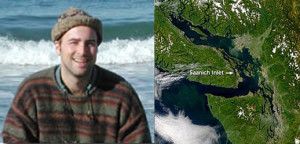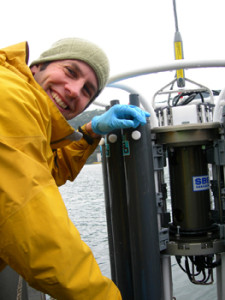WALNUT CREEK, CA—Among the many changes in the ocean is the expansion of oxygen-deficient or oxygen minimum zones (OMZs), also known as dead zones, which affect the processes by which carbon is captured and sequestered on the seafloor and alter the microbial activities that impact the rate and magnitude of ocean carbon sequestration. Despite the importance of these effects, very little is known about the metabolism of OMZ microbes and how they respond to environmental changes.
In the Oct. 23 issue of the journal Science, researchers from the University of British Columbia and the U.S. Department of Energy Joint Genome Institute (DOE JGI) describe the metagenome of an abundant but uncultivated microbe, known as SUP05, that is silently helping to shape the ecology of OMZs worldwide. Researchers studied the microbe in Saanich Inlet, a fjord on the coast of Vancouver Island, British Columbia, Canada. The fjord undergoes a seasonal cycle of stratification and deep water renewal, creating strong water column gradients that make it an ideal “living lab” to study microbial communities adapted and specialized to thrive under low oxygen conditions such as those found in OMZs. To chart the SUP05 metagenome, genetic material was recovered directly from environmental samples encompassing the entire microbial community of Saanich Inlet during different stages of water column stratification and deep-water renewal.

Photo, left: Steven Hallam of the University of British Columbia and senior author of the Oct. 23 paper in Science. Courtesy of the Hallam Lab. Photo, right: Map of Saanich Inlet, a seasonally anoxic fjord on the coast of Vancouver Island, British Columbia, Canada. Courtesy of the Hallam Lab.
“To our surprise the most abundant organism in the oxygen-depleted waters was this SUP05 bug,” said the paper’s senior author Steven Hallam, Assistant Professor at the University of British Columbia. “We obtained enough DNA sequence coverage from the community of microbes to actually assemble a continuous stretch representing what we are calling the SUP05 metagenome—it’s a composite of the entire SUP05 population spanning the various environmental samples that we sequenced.”
Susannah Tringe, a metagenomics scientist at the DOE JGI, said that the OMZs are sinks for an essential nutrient that marine organisms need to survive—nitrogen—as well as sources for the greenhouse gases methane and nitrous oxide. “By studying the genomes of the uncultivated microbes found in OMZs, we can better understand how they participate in global geochemical cycles such as the carbon and nitrogen cycles,” she said.
The project is part of the DOE JGI’s Community Sequencing Program established in 2004 to take on large-scale genomics efforts in support of DOE mission areas, including characterizing the biological and environmental processes involved in carbon cycling.

Study first author David Walsh of the University of British Columbia on a
water sampling trip at Saanich Inlet. Courtesy of the Hallam Lab.
Hallam described SUP05 as a paradoxical organism. “Based on genomic analysis and field observations, it provides important ecosystem services but it also produces byproducts that may have negative consequences with respect to climate change,” he said. “Specifically, SUP05 removes toxic sulfides from the water, and fixes carbon dioxide but we also think it’s producing nitrous oxide, which is a more potent greenhouse gas than either carbon dioxide or methane.”
The researchers found that SUP05 is closely related to sulfur-eating gill symbionts of deep sea clams and mussels although unlike them, it utilizes nitrate rather than oxygen in its energy metabolism. A comparative analysis of SUP05 and symbiont genomes also revealed that 35 percent of the SUP05 genome is unique, involved in helping the bacteria adapt to changing environmental conditions such as the seasonal increase and decrease of oxygen levels in Saanich Inlet, and the shifting balance of the nitrate and sulfide levels that are its key energy resources.
“As habitat range expands due to global warming, blooming SUP05 populations have the potential to help offset rising carbon dioxide levels that ultimately lead to ocean acidification,” Hallam said. He added that SUP05 and its relatives will become increasingly important agents as OMZ expansion and intensification continues to unfold, providing researchers with a biological indicator useful in monitoring the changing state of the global ocean.

Study second author Elena Zaikova of the University of British Columbia
collecting water samples in Saanich Inlet. Courtesy of the Hallam Lab.
“Just as cyanobacteria play an essential role in producing atmospheric oxygen; in future oceans this could be one of those organisms that play similarly integral roles, albeit with different ecological outcomes,” Hallam said. An overview of the project can be viewed at: http://www.cmde.science.ubc.ca/hallam/index.php.
The researchers plan to do further time course and metabolic monitoring studies in Saanich Inlet in conjunction with the Victoria Experimental Network Under the Sea (VENUS) cabled observatory program to better constrain the ecological roles of SUP05 and other, less abundant community members. Additionally, they hope to use the time-resolved studies in Saanich Inlet as a basis for comparison in the context of another CSP project of Hallam’s that was approved earlier this year and focuses on an extensive OMZ in the eastern North Pacific Ocean.
The U.S. Department of Energy Joint Genome Institute, supported by DOE’s Office of Science, is committed to advancing genomics in support of DOE missions related to clean energy generation and environmental characterization and cleanup. DOE JGI, headquartered in Walnut Creek, Calif., provides integrated high-throughput sequencing and computational analysis that enable systems-based scientific approaches to these challenges. Follow DOE JGI on Twitter.